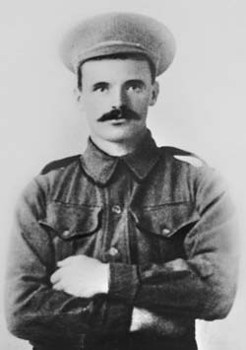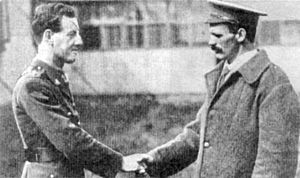Martin O'Meara facts for kids
Quick facts for kids
Martin O'Meara
|
|
|---|---|

Private Martin O'Meara c. 1915–16
|
|
| Born | 6 November 1885 Terryglass, Lorrha, Ireland |
| Died | 20 December 1935 (aged 50) Perth, Western Australia |
| Buried |
Karrakatta Cemetery, Perth
|
| Allegiance | Australia |
| Service/ |
Australian Imperial Force |
| Years of service | 1915–1919 |
| Rank | Sergeant |
| Unit | 16th Battalion |
| Battles/wars | First World War |
| Awards | Victoria Cross |
Martin O'Meara (born 6 November 1885 – died 20 December 1935) was an Australian soldier born in Ireland. He was awarded the Victoria Cross, which is the highest award for bravery given to soldiers from Britain and the Commonwealth. This medal is given for incredible courage when facing the enemy.
Contents
Martin O'Meara's Early Life
Martin O'Meara was born in Lorrha, County Tipperary, Ireland. He spent his childhood there. By 1911, he was working as a wood cutter in County Kilkenny.
In 1912, he moved to South Australia. He first worked as a labourer. Later, he worked on railway building projects in Port Augusta and McLaren Vale.
He then moved to Western Australia in 1914. He worked as a labourer in the Pinjarra area. After that, he worked as a sleeper cutter near Collie. On 19 August 1915, he joined the Australian Army.
Martin O'Meara in World War I
Martin O'Meara became a private in the 16th Battalion. He sailed from Australia to Egypt in December 1915. In Egypt, he served as an infantry soldier and also with a machine gun team.
In June 1916, he arrived in France. He joined the 16th Battalion's new Scouting Section. In this role, he worked as a scout, observer, and sniper. He served on the Western Front in Belgium and France.
Bravery at Pozières
Between 9 and 12 August 1916, there was very heavy fighting at Mouquet Farm, near Pozières. This was part of the Battle of Pozières. During these four days, Private O'Meara showed amazing courage.
He repeatedly went into "no man's land" to rescue wounded soldiers. "No man's land" was the dangerous area between the two enemy armies. He did this while under heavy fire from enemy artillery and machine-guns. He also bravely carried ammunition and bombs through intense shelling to parts of the trenches that were being heavily attacked.
Martin O'Meara was wounded three times during the war. He was hurt near Mouquet Farm in August 1916. He was also wounded near Bullecourt in April 1917 and near Messines in August 1917.
King George V presented him with his Victoria Cross medal. This happened at Buckingham Palace on 21 July 1917.
In 1918, he was chosen to return to Australia. He went with other Victoria Cross winners to help with recruiting new soldiers. He was promoted to Sergeant in August 1918. He left England in September 1918 and arrived in Western Australia in November 1918.

Life After the War
After arriving back in Western Australia, Martin O'Meara faced health challenges. He was cared for in hospitals that helped soldiers. He stayed at Lemnos Soldier's Hospital for many years.
He passed away in December 1935, at the age of 50. He was buried in Karrakatta Cemetery in Perth, Western Australia.
Martin O'Meara's Victoria Cross Medal
Martin O'Meara's Victoria Cross medal is kept at the Army Museum of Western Australia in Fremantle. In 2019, the Australian government loaned the medal to the National Museum of Ireland. It was on display there for a year. This loan was a special event that allowed people in Ireland to see this important piece of history.

